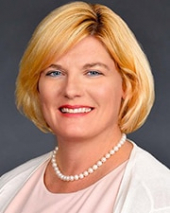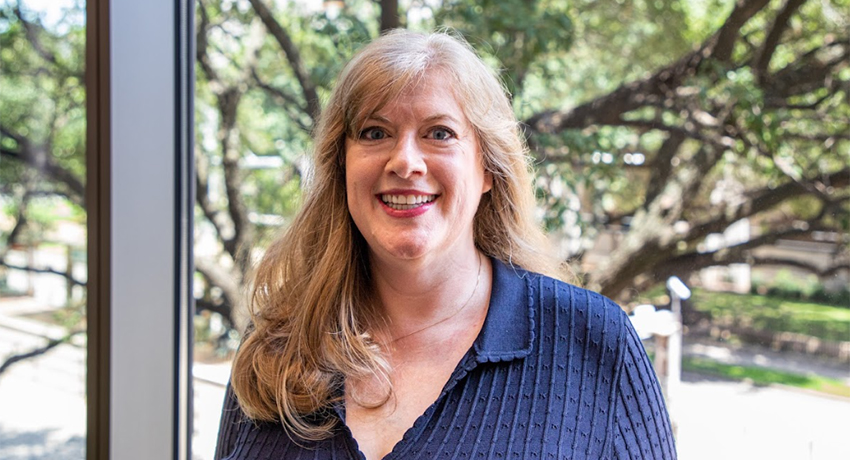Migraine headaches have been a part of Christine Ryan’s life for more than 30 years. She visited nine doctors searching for answers and experienced three ER visits as a result.
“It definitely changes your goals and what you envision for yourself, but it also makes you fight harder, get support, and figure out a different way,” Christine said. “You just have to take a different door to accomplish what you want in life.”
For Christine, as a stay-at-home mom years ago with three young children, she tried to manage her pain with over-the-counter medication and other tools, but it wasn’t enough. She had to make sure she was doing things a different way. That might mean lying down for 30 minutes, using an ice pack, and then making sure to eat something before handling the school carpool. She would have to lie down another 30 minutes before doing laundry. With three kids in close age, she realized she couldn’t help everyone with homework or take them to activities. It required daily planning to make sure it all got done.
On her worst days, she might end up lying on the floor, not able to move, with her head feeling like it was going to burst.
“You just want a silver bullet. You want the pain to stop,” Christine said. “But there really isn’t such a thing with migraines.”

Fortunately, Christine found Kimberly Monday, MD, neurologist with UTHealth Houston Neurosciences and associate professor at McGovern Medical School at UTHealth Houston, who prescribed the first medication that made a difference in controlling Christine’s migraines.
“Migraines are disabling, and patients will do anything to avoid the pain and life disruption,” Monday said. “Christine’s migraines were not well controlled, and this directly affected her quality of life. She had already gone above and beyond to control her triggers, maximizing non-pharmaceutical solutions to function successfully for her family.”
A long journey
Monday has worked with Christine and her migraine journey for the past 12 years. As part of the initial appointment history, Monday reviews sleep habits, caffeine intake, stressors, and triggers. She said patients are savvy and can identify triggers on their own, as well.
Oftentimes, people who suffer from migraines will use over-the-counter medications daily just to function. But Monday said using these creates a secondary problem — medication overuse headache — in addition to migraines.
About 10 years ago, even under Monday’s care, Christine experienced migraines every day for seven months.
“It felt like someone had driven a stake in the back of my skull and was tapping on it all day,” Christine said.
Monday decided to take Christine off all her medication. She started her on a new regime of injections every three months into a trigger point at the base of her skull. Monday said migraine treatment plans have to commonly be adjusted based on life changes, other medical conditions, hormonal changes, and side effect profiles.
“If all non-pharmaceutical options have been maximized, targeted medications truly improve quality of life,” Monday said. “Migraine treatment has expanded with the development of a new medication class termed calcitonin gene-related peptide receptors (CGRPs). Christine has benefitted from this.”
Christine has experienced the huge shift in medicine through the years. Until about three years ago, doctors prescribed Christine medications that were designed to treat conditions other than migraines, such as seizures or high blood pressure — often with many side effects. Monday prescribed Christine one of the first CGRP medications, which was an injection in her leg once a month, which worked for about two years. Now, she takes a daily pill.
“Dr. Monday is constantly looking for an answer or new medication,” Christine said. “She is great at taking feedback from patients and advocating for patients with health insurers and drug companies about new medications.”
Christine is most pleased that her current medication is specifically designed to treat migraines.
Setting herself up for success
Christine has learned to advocate for herself and created a “toolbox” that can prevent or provide relief from migraines. This has been an evolving process for 25 years. Christine has not been to the ER for migraines since she started seeing Monday.
Ryan’s toolbox:
- Ice for pain
- Heat for pain or comfort
- Prescription sunglasses to decrease light
- Ear plugs
- Tennis ball
- Foam roller/therapy ball to roll out sore muscles
- Stretching
- Food
- Water — stay hydrated
- Mouthguard — grinding, clenching
- Monitor allergies
- Calendar to track hormone cycle, eating and sleeping patterns, allergies
- Bedroom — cool, dark (blackout curtains) side sleep with support, no clutter, good mattress
- Exercise — know when to stop and when your movement isn’t working for you
“I have to be proactive and in touch with what my body is trying to tell me,” Christine said. “I want to ignore those signs of the migraine rolling in, but if I do, my body will win and shut me down. The more I listen to it, the more I can put on my plate and accomplish.”
Christine never thought she’d get to this point regarding her frequency of migraines. Today, she gets migraines about every other week. Travel can also trigger a migraine, but she’s learned the best way to manage them by planning ahead to avoid her migraine triggers.
“I’m so appreciative of all the things Dr. Monday has done,” Christine said. “Migraine patients don’t like to talk about their pain, the frustration, the guilt, and the things they can’t accomplish. She understands what the migraine patient journey is like and makes you feel comfortable about opening up with those things.”
Ryan’s personal toolbox:
- Prioritize sleep
- Manage stress
- Prioritize your energy:
- Plan how to use energy throughout the day/week
- Take a nap without guilt
- Monitor working days/time from home
- Adjust driving time with low traffic or carpool
- Don’t skip meals
- Advocate for yourself:
- Don’t suffer in silence
- Tell people what you need
- Say “no” without an explanation
Advice for others
One of the most important pieces of advice Christine can offer to those who suffer from migraines is to be patient with yourself. She stresses the importance of seeing a neurologist, who understands the big picture.
“You also need to be patient with finding a good provider,” Christine continued. “You’re going to have to keep trying, but definitely start with a neurologist.”
During the times over the years when Christine was not able to do all the things she wanted to do because of migraines, she felt frustrated and exhausted. The mom-guilt also plagued her.
“Feelings of guilt don’t serve us well,” Christine said. “When I asked my daughter of her memories of those times, she remembered me as being really strong. ‘I didn’t see you missing out, I was a teenager. I love how you’re using the term “toolbox” and not “crutch.”’”
Monday offers her own advice for migraine sufferers:
- Take control and manage your triggers.
- Share your journey with family and friends to enhance their understanding of your limitations.
- Keep a calendar, or download an app, to track your headaches.
- See your physician if you find yourself taking over-the-counter medication more than once a week to manage symptoms.
- Do not suffer in silence. Migraines are common and very treatable.


